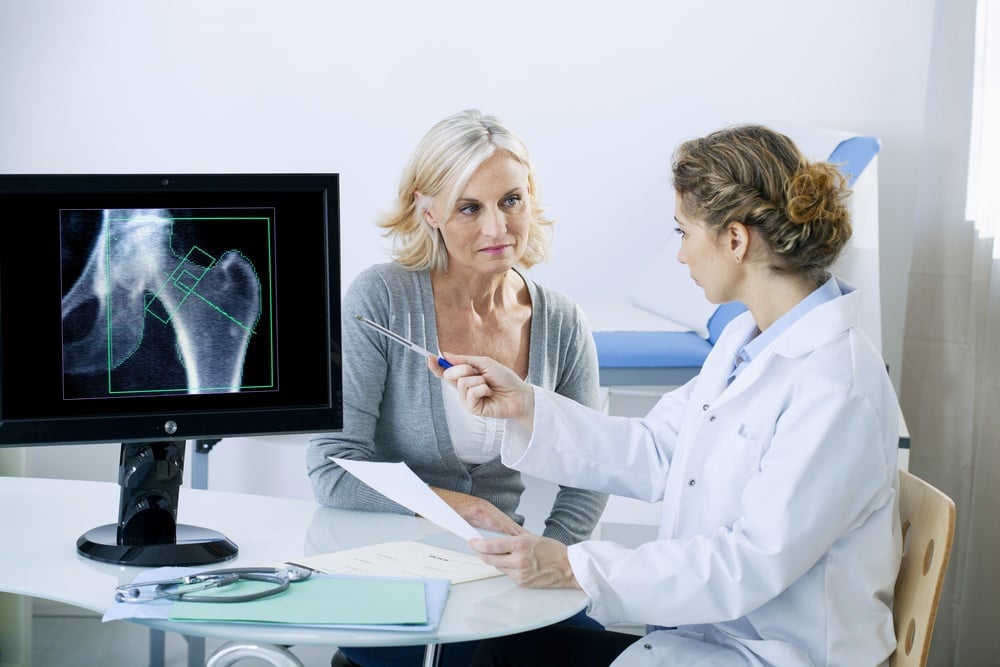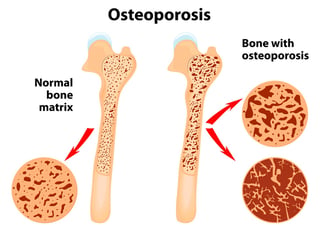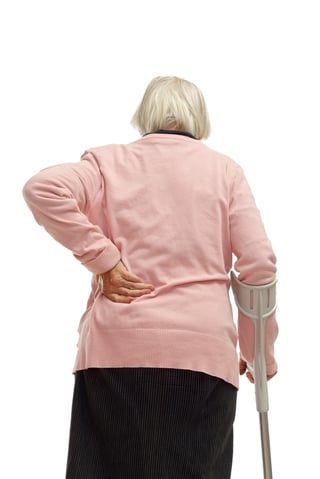What is Osteoporosis? Signs, Symptoms, and Risks
April 14th, 2016 | 3 min. read

Osteoporosis, meaning "porous bones," is a disease affecting bone density. Over time, bones become less dense — thinner and more fragile — which can lead to an increased risk of fracture. Osteoporosis affects about 9 million Americans, both men and women. How do you know if you're at risk?
First, what is osteoporosis, and why does bone density decrease as we age?
OSTEOPOROSIS: how it happens
 In our early lives, our bones break down and replace themselves continuously through a growth process called bone remodeling.
In our early lives, our bones break down and replace themselves continuously through a growth process called bone remodeling.
We reach peak bone mass, and bone strength, in our twenties.
In our thirties, the bone remodeling process changes. Bones begin to lose calcium faster than they can replace it, leading to a breakdown of bone tissue known as resorption.
When resorption happens faster than the creation of new bone, bones become thinner and more porous. This process is known as bone loss.
Some degree of bone loss happens to most people, but osteoporosis is a more serious form where bones become brittle and prone to fracture.
why worry about osteoporosis?
Osteoporosis most often affects the bones of the wrist, hip, and spine. These fractures are debilitating at any stage of life. However, because bone growth slows down as we age, healing broken bones takes much longer when we're older. A long rehabilitation often means greatly reduced mobility for an extended period of time, which can contribute to other, sometimes life-threatening health problems like blood clots.
Also, orthopedic surgery may be required for hip breaks or spinal fractures. All surgeries have risk, but the risks associated with surgery and anesthesia increase with age.
Lastly, osteoporosis is a concern for older adults because some fractures can lead to deformities of the spine, permanent disability, or a loss of independence.
RISK FACTORS FOR OSTEOPOROSIS
Loss of bone density is common as we age. Osteoporosis can happen to men, but in the U.S., women constitute about 80% of all diagnosed cases. Most of these are women who are past menopause.
Generally, the following are risk factors for osteoporosis:

- Age. If you are a woman who is past menopause, especially in the 5 to 7 years after, the natural decline in your estrogen levels may make you more susceptible to bone loss. (Research indicates that estrogen helps the body retain calcium.)
- Race. People of white or Asian descent are more frequently affected by osteoporosis than those of other backgrounds.
- Size. The less dense your bones are at their peak, the more likely you are to develop osteoporosis as you age. If you are underweight, thin, or with a small frame, you may be at greater risk.
- Family history. If your parents had osteoporosis or hip fractures, you are more likely to develop the condition.
- Medical history. Kidney disease, Cushing's syndrome, an overactive thyroid, an overactive parathyroid or adrenal gland, gastrointestinal surgery, or having an oophorectomy (ovary removal) are all associated with an increased risk of osteoporosis. Paralysis or prolonged immobility due to illness can also affect your bone density.
- Diet. Long-term nutritional deficits of calcium and protein can increase your risk of bone loss. Eating disorders like anorexia are associated with a greater risk for this reason.
- Medications. Corticosteroids interrupt the bone rebuilding process; taking them long-term may affect bone density. Anti-seizure medications or too much thyroid hormone to treat under-active thyroid may have a similar effect.
- Lifestyle. Smoking, drinking more than two drinks per day, and a sedentary lifestyle are all known risk factors.
SIGNS and symptoms OF OSTEOPOROSIS
In the early stages of bone loss, symptoms are not that common. However, as the disease advances you may notice the following:
- Bone fractures that happen too easily
- Back pain
- Loss of height
- Stooped posture or a hump in the back
Back pain or a change in your posture may indicate crumbling vertebrae, which is why many older people with osteoporosis report "shrinking."
treatment of OSTEOPOROSIS
If you have any of the risk factors listed above, see your doctor for a bone density test. If you are diagnosed with osteoporosis, your physician will advise you of the best course of treatment depending on your lifestyle, your age, your medical history, and any medications you're currently taking.
Depending on these factors, treatment options for osteoporosis may include:
- Hormone therapy (estrogen replacement, testosterone replacement, or related medications)
- Lifestyle changes (diet and exercise)
- Medication (bisphosphonates or injections of bone-growth stimulating drugs like denosumab or teriparatide)
- Modification of risk factors, like changing your shoes to a low heel to decrease your chance of a fall
- Orthopedic surgery or fracture care management
Coastal Orthopedics can help you explore your treatment options. Is it time for an assessment? Call us at our Corpus Christi location and make an appointment today!
Article written by: Rob Williams, MD
Dr. Williams has been practicing orthopedic surgery in Corpus Christi since 1998. After graduating from Texas Tech hereceived his medical degree from the University of Texas at San Antonio. At the prestigious Campbell Clinic located at the University of Tennessee, Dr. Williams completed not only an Orthopedic Surgery Residency, but an additional year of Fellowship Training in Spine Surgery. Dr. Williams is dedicated to creating an excellent patient experience in the office or in the surgery suite.

